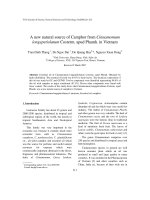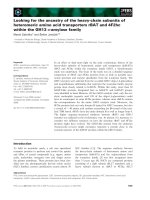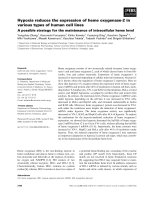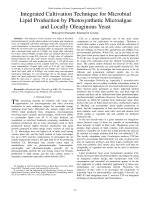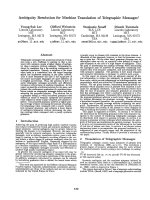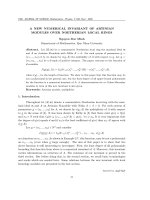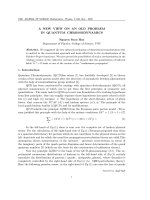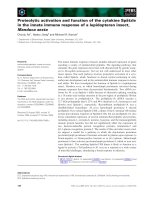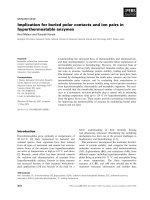Báo cáo "A new formulation for fast calculation of far field force in molecular dynamics simulations " ppt
Bạn đang xem bản rút gọn của tài liệu. Xem và tải ngay bản đầy đủ của tài liệu tại đây (157.11 KB, 8 trang )
VNU Journal of Science, Mathematics - Physics 23 (2007) 1-8
A new formulation for fast calculation of far field force in
molecular dynamics simulations
Nguyen Hai Chau
∗
Department of Infomation Technology, College of Technology, VNU
144 Xuan Thuy, Cau Giay, Hanoi, Vietnam
Received 25 November 2006; received in revised form 7 August 2007
Abstract. We have developed a new formulation for fast calculation of far-field force of
fast multipole method (FMM)in molecular dynamics simulations. FMM is a linear algorithm
to calculate force for molecular dynamics simulations. GRAPE is a special-purpose computer
dedicated to Coulombic force calculation. It runs 100-1000 times faster than normal computer
at the same price. However FMM cannot be implemented directly on GRAPE. We have
succeeded to implement FMM on GRAPE and developed a new formulation for far-field force
calculation. Numerical tests show that the performance of FMM using our new formulation
on GRAPE is approximately 2-5 times faster than that of FMM using conventional far field
formulation.
1. Introduction
Molecular dynamics (MD) simulations often require high calculation cost. The most intensive
part of MD is calculation of Coulombic force among particles (i.e. atoms and ions). In naive direct-
summation algorithm, cost of the force calculation scales as O(N
2
), where N is the number of particles.
In order to reduce the cost of force calculation, fast algorithms such as Barnes-Hut treecode [1] and
fast multipole method [2] have been designed. Calculation cost of these algorithms are O(N. log N)
and O(N), respectively. These fast algorithms are widely used in the field of MD simulation [3, 4].
Another approach to accelerate the force calculation is to use hardware dedicated to the calcu-
lation of inter-particle force. GRAPE (GRAvity PipE) [5, 6] is one of the most widely used hardware
of that kind. Figure 1 shows basic structure of a GRAPE system. It consists of a GRAPE processor
board and a general-purpose computer (hereafter the host computer).
A typical GRAPE system performs force calculation 100-1000 times faster than conventional
computers of the same price do. For small-N (N
∼
<10
5
) systems, combination of simple direct-
summation algorithm and GRAPE is the fastest and simplest calculation scheme. However, for large-N
systems, O(N
2
) direct-summation becomes expensive, even with GRAPE hardware. Combination of
a fast algorithm and fast hardware will deliver extremely high performance for large N. Makino et al
[7] have successfully implemented a modified treecode [8] on GRAPE, and achieved a factor of 30-50
speed up.
∗
Tel: 84-4-7547813.
E-mail:
1
2 Nguyen Hai Chau / VNU Journal of Science, Mathematics - Physics 23 (2007) 1-8
Positions,
charges
Forces
HOST
COMPUTER
GRAPE
Figure 1. Basic structure of a GRAPE system.
Implementation of FMM on dedicated hardware of similar kind (MD-ENGINE) has been re-
ported, but its performance is rather modest [9]. This is mainly because the hardware limitation. Since
dedicated hardware can calculate the particle force only, they cannot handle multipole and local ex-
pansions. Therefore only a small fraction of the calculation procedure in the FMM can be performed
on such hardware, and the speed up gain remains rather modest. An outstanding problem is how to
perform a large or all fraction of FMM’s calculation procedure on GRAPE.
We have implemented FMM on GRAPE and achieved significant speedup [10]. However we
have not succeeded to put far field calculation part of FMM to GRAPE. This fact limits the performance
of FMM on GRAPE.
In this paper we describe our new formulation to speed up far field force calculation – a sig-
nificant calculation part of FMM on GRAPE. Remaining parts of the paper are organized as follows.
In section 2 we gives a summary of the FMM and related algorithms as well as describe the imple-
mentation of our FMM code and its limitation. Section 3 presents our new formulation. Results of
numerical tests are shown in section 4. Section 5 summarizes.
2. FMM and its variant implementations
2.1. FMM
The FMM [2, 11] is an approximate algorithm to calculate force among particles. In the case
of close-to-uniform distribution, its computation complexity is O(N). This scaling is achieved by
approximation of force using the multipole and local expansion technique.
Figure 2 shows schematic idea of force approximation in the FMM. The force from a group of
distant particles are approximated by a multipole expansion. At an observation point, the multipole
expansion is converted to local expansion. The local expansion is evaluated by each particle around
the observation point. Hierarchical tree structure is used for grouping of the particles [2, 11].
M2M
M2L
L2L
Multipole expansion Local expansion
Figure 2. Schematic idea of force approximation in FMM.
Nguyen Hai Chau / VNU Journal of Science, Mathematics - Physics 23 (2007) 1-8 3
2.2 Anderson’s method
Anderson [12] proposed a variant of the FMM using a new formulation of the multipole and
local expansions. His method is based on the Poisson’s formulae. In order to use these formulae as
replacements of the multipole and local expansions, Anderson proposed discrete versions of them as
follows. When potential on the surface of a sphere of radius a is given, the potential Φ at position
r = (r, φ, θ ) is expressed as:
Φ(r) ≈
K
i=1
p
n=0
(2n + 1)
a
r
n+1
P
n
s
i
·r
r
Φ(as
i
)w
i
(1)
for r ≥ a (outer expansion) and
Φ(r) ≈
K
i=1
p
n=0
(2n + 1)
r
a
n
P
n
s
i
·r
r
Φ(as
i
)w
i
(2)
for r ≤ a (inner expansion). The function P
n
denotes the n-th Legendre polynomial. Here w
i
are con-
stant weight values and p is the number of untruncated terms. Hereafter we refer p as expansion order.
Anderson’s method uses Eq. (1) and (2) for M2M and L2L transitions, respectively. The procedures of
other stages are the same as that of the original FMM. Note that Anderson used spherical t-design [13]
to obtain Eq. (1) and (2). Examples of spherical t-design is available at />njas/sphdesigns/.
2.3. Pseudoparticle multipole method
Makino [14] proposed the pseudoparticle multipole method (P
2
M
2
). The advantage of his method
is that the expansions can be evaluated using GRAPE.
Makino’s idea is very similar to Anderson’s. Both methods uses discrete quantity to approximate
the potential field of the original distribution of the particles. The difference is that P
2
M
2
uses the
distribution of point charges, while the Anderson’s method uses potential values. In the case of P
2
M
2
,
the potential is expressed by point charges as given below, and thus it can be evaluated using GRAPE.
Q
j
=
N
i=1
q
i
p
l=0
2l + 1
K
r
i
a
l
P
l
(cos γ
ij
), (3)
where Q
j
is charge of pseudoparticle, r
i
= (r
i
, φ, θ) is position of physical particle, γ
ij
is angle
between r
i
and position vector
R
j
of the j-th pseudoparticle [14].
Implementation of the FMM on GRAPE In this section, we briefly describes our implementation on
GRAPE [10]. The FMM consists of five stages, namely, tree construction, M2M transition, M2L
conversion, L2L transition, and force evaluation. Force-evaluation stage consists of near field and far
field evaluation parts.
In the case of original FMM, only the near field part of the force-evaluation stage can be
performed on GRAPE. In our implementation (hereafter code A), we modified the original FMM so
that GRAPE can handle M2L conversion stage, which is most time consuming. Table 1 summarizes
mathematical expressions and operations used at each calculation stage. In the following we describe
stages of the code A.
4 Nguyen Hai Chau / VNU Journal of Science, Mathematics - Physics 23 (2007) 1-8
Table 1. Mathematical expressions and operations used in our implementation of the code A [10]. Bold parts
run on GRAPE.
Original [11] Code A (section 2)
M2M multipole expansion P
2
M
2
M2L M2L conversion evaluation of
formula pseudoparticle potential
L2L local expansion Anderson’s method
Near field force evaluation of physical-particle force
Far field force evaluation of Eq. (4)
local expansion
The tree construction stage has no change. It is performed in the same way as in the original
FMM.
At the M2M transition stage, we compute positions and charges of pseudoparticles, instead of
forming multipole expansion as in the original FMM. This process is totally done on the host computer.
The M2L conversion stage is done on GRAPE. Difference from the original FMM is that we do
not use the formula to convert multipole expansion to local expansion. We directly calculate potential
values due to pseudoparticles.
The L2L transition is done in the same way as Anderson has done using Eq. (2).
The near field contribution is directly calculated by evaluating the particle-particle force. GRAPE
handles this part.
Using Eq. (2), we obtain the far field potential on a particle at position r. Consequently, far
field force is calculated using derivative of Eq. (2):
−∇Φ(r) =
K
i=1
p
n=0
nrP
n
(u) +
ur −s
i
r
√
1 −u
2
∇P
n
(u)
(2n + 1)
r
n−2
a
n
g(as
i
)w
i
, (4)
where u = s
i
·r/r. All the calculation at this stage is done on the host computer.
With the modification to original FMM described above, we have succeeded to put the bottleneck,
namely, the M2L conversion stage, on GRAPE. The overall calculation of the FMM is significantly
accelerated. Now the most expensive part is the far field force evaluation. A new bottleneck appears.
Eq. (4) is complicated and evaluation of it takes rather big fraction of the overall calculation time [10].
If we can convert a set of potential values into a set of pseudoparticles at marginal calculation
cost, force from those pseudoparticles can be evaluated on GRAPE, and the new bottleneck will
disappear. In order for this conversion, we have newly developed a conversion procudure (hereafter
A2P conversion) presented in section 3.
3. A new formulation for fast calculation of far field force
Eq. (3) gives solution for outer expansion of P
2
M
2
. Using a similar approach, we obtained
solution for inner expansion as:
Q
j
=
N
i=1
q
i
p
l=0
2l + 1
K
a
r
i
l+1
P
l
(cos γ
ij
). (5)
Nguyen Hai Chau / VNU Journal of Science, Mathematics - Physics 23 (2007) 1-8 5
In the following we give derivation procedure for Eq. (5). The local expansion of the potential Φ(r)
is expressed as
Φ(r) = 4π
p
l=0
l
m=−l
β
m
l
r
l
Y
m
l
(θ, φ). (6)
Here, Y
m
l
(θ, φ) is the spherical harmonics and β
m
l
is the expansion coefficient. In order to approximate
the potential field due to the distribution of N particles, the coefficients should satisfy
β
m
l
=
1
2l + 1
N
i=1
q
i
1
r
l+1
i
Y
m∗
l
(θ
i
, φ
i
), (7)
where q
i
and r
i
= (r
i
, θ
i
, φ
i
) are the charges and positions of the particles, and * denotes the complex
conjugate.
In order to reproduce the expansion Φ(r) up to p-th order, the charges Q
j
and the positions
R
j
= (R
j
, θ
j
, φ
j
) of pseudoparticles must satisfy
β
m
l
=
1
2l + 1
K
j=1
Q
j
1
R
l+1
j
Y
m∗
l
(θ
j
, φ
j
) (8)
for all (p + 1)
2
combinations of l and m in the range of 0 ≤ l ≤ p and −l ≤ m ≤ l. Here K is the
number of pseudo particles.
Following Makino’s approach [14], we restrict the distribution of pseudoparticles to the surface
of a sphere centered at the origin. With this restriction, the coefficients of local expansion generated
by the pseudoparticles are expressed as
β
m
l
=
1
(2l + 1)b
l+1
K
j=1
Q
j
Y
m∗
l
(θ
j
, φ
j
), (9)
where b is the radius of the sphere. If we consider the limit of infinite K, Eq. (9) is replaced by
β
m
l
=
1
(2l + 1)b
l−1
S
ρ(a, θ, φ) Y
m∗
l
(θ, φ)ds. (10)
Here S is the surface of a unit sphere, and ρ is the continuous charge representation of pseudoparticle. In
this limit, the charge distribution is obtained by the inverse transform of spherical harmonics expansion
as follows:
ρ(a, θ, φ) =
∞
l=0
l
m=−l
(2l + 1)b
l−1
β
m
l
Y
m
l
(θ, φ). (11)
We can discretize ρ using the spherical t-design. In other words, the spherical t-design gives a
distribution of pseudoparticles over which numerical integration retains the orthogonality of spherical
harmonics up to p-th order. The charges of the pseudoparticles are then obtained as
Q
j
=
4π
K
p
l=0
l
m=−l
(2l + 1)b
l+1
β
m
l
Y
m
l
(θ
j
, φ
j
). (12)
This equation gives the charges Q
j
of pseudoparticles from the expansion coefficients of physical
particles β
m
l
. In practice, we can directly calculate Q
j
from the charges q
i
and the positions r
i
of
physical particles.
6 Nguyen Hai Chau / VNU Journal of Science, Mathematics - Physics 23 (2007) 1-8
Combining Eq. (7) and Eq. (12), Q
j
is expressed as
Q
j
=
4π
K
p
l=0
l
m=−l
N
i=1
q
i
b
r
i
l+1
Y
m
l
(θ
j
, φ
j
)Y
m∗
l
(θ
i
, φ
i
). (13)
Using the addition theorem of spherical harmonics, we can simplify this equation and obtain the
formula to give Q
j
from q
j
and r
i
:
Q
j
=
N
i=1
q
i
p
l=0
2l + 1
K
b
r
i
l+1
P
l
(cos γ
ij
). (14)
Using the new formula (14), we have implemented yet another version of FMM (hereafter code
B). Table 2 describes stages in code B. In the code B, we use A2P conversion to obtain a distribution
of pseudoparticles that reproduces the potential field given by Anderson’s inner expansion. Once the
distribution of pseudoparticles is obtained, L2L stage can be performed using inner-P
2
M
2
formula (Eq.
(5)), and then the force evaluation stage is totally done on GRAPE (see table 2). Procedure of A2P
conversion is as follows.
Table 2. Mathematical expressions and operations used in the code B. Bold parts run on GRAPE.
Original [11] Code B (section 3)
M2M multipole expansion P
2
M
2
M2L M2L conversion evaluation of
formula pseudoparticle potential
L2L local expansion P
2
M
2
Near field force evaluation of physical-particle force
Far field force evaluation of evaluation of
local expansion pseudoparticle force
At the first step, we distribute pseudoparticles on the surface of a sphere with radius b using
the spherical t-design. Here, b should be larger than the radius of the sphere a on which Anderson’s
potential values Φ(as
i
) are defined. According to Eq. (5), it is guaranteed that we can adjust the
charge of the pseudoparticles so that Φ(as
i
) are reproduced. Therefore, the relation
K
j=1
Q
j
|
R
j
− a s
i
|
= Φ(a s
i
) (15)
should be satisfied for all i = 1 K. Using a matrix R = {1/|
R
j
− a s
i
|} and vectors
Q =
T
[Q
1
, Q
2
, , Q
K
] and
P =
T
[Φ(a s
1
), Φ(a s
2
), , Φ(a s
K
)], we can rewrite Eq. (15) as
R
Q =
P . (16)
In the next step, we solve the linear Eq. (16) to obtain charges Q
j
. By numerical experiment,
we found that appropriate value of radius b is about 6.0, for particles inside a cell with side length
1.0. Anderson specified in his paper [12] that a should be about 0.4.
Nguyen Hai Chau / VNU Journal of Science, Mathematics - Physics 23 (2007) 1-8 7
1
10
100
1000
4M2M1M512K256K128K
Calculation time (second/step)
Number of particles N
N
200
Figure 3. Comparison of the code A and B. Squares are performance of code A
on MDGRAPE-2. Circles are that of code B. Open and filled symbols are for low (p = 1)
and high accuracy (p = 5), respectively.
4. Numerical results
Here we show the performance of the FMM code B and compare performance of the code A
and B measured on MDGRAPE-2 [15]. MDGRAPE-2 is one of the latest hardware of the GRAPE
series. It is developed for MD simulation.
Our test system consists of one MDGRAPE-2 board (16 pipelines, 48GFlops) and a host com-
puter Pentium 4 2.2GHz, Intel D850 motherboard.
In the tests, we distributed particles uniformly within a unit cube centered at origin, and evaluated
force on all particles. We measured the calculation time at high (p = 5) and low (p = 1) accuracy,
with and without GRAPE. The finest refinement level l
max
is set to l
max
= 4 and 5, for runs with
and without GRAPE, respectively. These values are chosen so that the overall calculation time is
minimized. Result is shown in figure 3. Notation K and M on the figures are 1024 and 1024*1024,
respectively.
In figure 3 we compare the performance of code A and code B on our test computer system.
Since code B uses the A2P conversion procedure, it runs approximately faster than code A 2 times for
low accuracy and 5 times for high accuracy.
5. Summary
We have developed a new formulation and a new calculation procedure to speed up the calcu-
lation of far field force in FMM implementation on special-purpose hardware GRAPE. Employing the
new formulation, our new code (code B) is of higher performance than the treecode at high accuracy.
The numerical results show that the code B performs approximately 2-5 times faster than the code A
[10] which uses conventional formulation of calculation.
8 Nguyen Hai Chau / VNU Journal of Science, Mathematics - Physics 23 (2007) 1-8
Acknowledgements. This work is supported by Advanced Computing Center, Institute of Phys-
ical and Chemical Research (RIKEN), Japan; Institute of Information Technology, Vietnam National
University, Hanoi under QCT.05.07 project; and College of Technology, Vietnam National University,
Hanoi under QC.05.01 project.
References
[1] J.E. Barnes, P. Hut, A hierarchical O(N log N ) force-calculation algorithm, Nature 324 (1986) 446.
[2] L.Greengard, V. Rokhlin, A fast algorithm for particle simulations, Journal of Computational Physics 73 (1987) 325.
[3] P. Lakshminarasimhulu, J.D. Madura, A cell multipole based domain decomposition algorithm for molecular dynamics
simulation of systems of arbitrary shape, Computer Physics Communications 144 (2002) 141.
[4] J.A. Lupo, Z.Q. Wang, A.M. McKenney, R. Pachter, W. Mattson, A large scale molecular dynamics simulation code
using the fast multipole algorithm (FMD): performance and application, Journal of Molecular Graphics and Modelling
21 (2002) 89.
[5] D. Sugimoto, Y. Chikada, J. Makino, T. Ito, T. Ebisuzaki, M. Umemura, A special-purpose computer for gravitational
many-body problems, Nature 345 (1990) 33.
[6] J. Makino, M. Taiji, Scientific Simulations with Special-Purpose Computers - The GRAPE Systems (Chichester: John
Wiley and Sons, 1998).
[7] J. Makino, Treecode with a special-purpose processor, Publ. Astron. Soc. Japan 43 (1991) 621.
[8] J.E. Barnes, A modified tree code: Don’t laugh; It runs, Journal of Computational Physics 87 (1990) 161.
[9] T. Amisaki, S. Toyoda, H. Miyagawa, K. Kitamura, Development of hardware accelerator for molecular dynamics
simulations: a computation board that calculates nonbonded interactions in cooperation with fast multipole method.
Journal of Computational Chemistry 24 (2003) 582.
[10] N.H. Chau, A. Kawai, T. Ebisuzaki, Implementation of fast multipole algorithm on special-purpose computer
MDGRAPE-2, Proceedings of the 6th World Multiconference on Systemics, Cybernetics and Informatics SCI2002,
(Orlando, Colorado, USA, July 14-18, 2002) 477.
[11] L. Greengard, V. Rokhlin, A new version of the fast multipole method for the Laplace equation in three dimensions,
Acta Numerica 6 (1997) 229.
[12] C.R. Anderson, An implementation of the fast multipole method without multipoles, SIAM J. Sci. Stat. Comput. 13
(1992) 923.
[13] R.H. Hardin, N.J.A. Sloane, McLaren’s improve snub cube and other new spherical design in three dimensions, Discrete
and Computational Geometry 15 (1996) 429.
[14] J. Makino, Yet another fast multipole method without multipoles - pseudoparticle multipole method, Journal of Com-
putational Physics 151 (1999) 910.
[15] R. Susukita, T. Ebisuzaki, B.G. Elmegreen, H. Furusawa, K. Kato, A. Kawai, Y. Kobayashi, T. Koishi, G.D. McNiven, T.
Narumi, K. Yasuoka, Hardware accelerator for molecular dynamics: MDGRAPE-2, Computer Physics Communications
155 (2003) 115.
